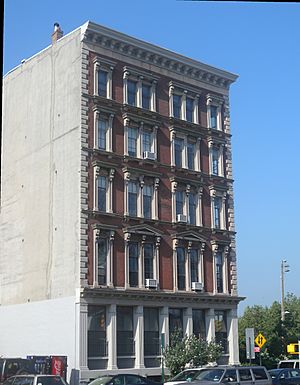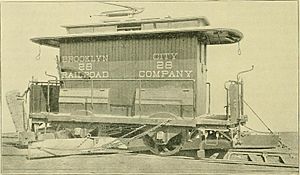Brooklyn City Railroad facts for kids
The Brooklyn City Railroad (BCRR) was one of the oldest and biggest companies that operated streetcars in the city of Brooklyn, New York. At first, they used horsecars, which were streetcars pulled by horses. Later, they switched to trolleys, which ran on electricity. The BCRR continued to be important even after Brooklyn became a part of New York City in 1898.
Contents
Starting the Brooklyn City Railroad
The Brooklyn City Railroad company was officially created on December 17, 1853. They started with a lot of money, about $2,500,000, which was a huge amount back then!
Their very first line was called the Myrtle Avenue Line. It was the first horsecar line ever in Brooklyn. It opened on July 3, 1854. This line ran from Fulton Ferry through Fulton Street and Myrtle Avenue. It ended at the old stagecoach stables on Marcy Avenue. In 1855, the New York State Legislature allowed the company to reduce its starting money to $1,000,000.
Many Streetcar Lines
The Brooklyn City Railroad grew a lot over the years. By 1893, it operated many different streetcar lines. These lines connected various neighborhoods across Brooklyn and even reached into parts of Queens.
Some of the important lines they ran included:
- The Court Street Line, which went from the Brooklyn Bridge to Red Hook.
- The Flatbush Avenue Line, connecting Fulton Ferry to Flatbush.
- The Fulton Street Line, running from Fulton Ferry to East New York.
- The Myrtle Avenue Line, which went from Fulton Ferry to Bushwick.
- The Third Avenue Line, connecting Fulton Ferry to Fort Hamilton.
Over time, the BCRR also took over lines from other smaller railroad companies. For example, they added lines from the Bushwick Railroad, the Brooklyn Crosstown Railroad, and the Grand Street and Newtown Railroad. This helped them expand their network even more. They even built new lines that went further into Queens, like the Corona Line to Corona.
Joining Forces: The Brooklyn Heights Railroad Lease
In 1893, a company called the Long Island Traction Company (LIT) bought the Brooklyn Heights Railroad (BHRR). The BHRR was a smaller company that ran a short cable car line in Brooklyn Heights. The LIT then used the BHRR to manage its operations.
In the same year, the Brooklyn Heights Railroad made a deal to operate the Brooklyn City Railroad for 999 years! By this time, the Brooklyn City Railroad was running 27 different streetcar lines.
Becoming Part of a Bigger System: BRT
The Long Island Traction Company (LIT) faced financial problems and was reorganized in 1895. It became the Brooklyn Rapid Transit Company (BRT). The BRT quickly started buying or leasing most of the trolley and rapid transit lines in Brooklyn.
The BRT became the main company for transportation in Brooklyn. However, the BRT still operated all its lines through smaller companies it owned or leased, like the Brooklyn City Railroad. Passengers might have noticed this because their streetcar transfers sometimes had "B.C.R.R." printed on them.
The Railroad's Comeback
In 1919, the BRT company ran into serious trouble and went into a state called "receivership." This means a court took control of the company because it was having financial problems. This happened due to several reasons, including the high cost of things after World War I. A terrible accident on the Brighton Line in 1918, which killed many people, also didn't help.
Even though the BRT was struggling, the Brooklyn City Railroad was declared financially stable. So, its original company status was brought back. The lease with the Brooklyn Heights Railroad ended. On October 19, 1919, the BCRR got back all the lines it had controlled in 1893, plus more.
The Brooklyn City Railroad had its own workers, streetcars, and places to store and fix the cars. They even bought new equipment under their own name. However, the overall planning and management were still largely handled by the BRT. One downside for passengers was that BCRR lines no longer gave transfers to lines still managed by the BRT, and vice versa.
When the BRT was reorganized as the Brooklyn–Manhattan Transit Corporation (BMT) in 1923, many of the old BRT companies gradually got out of receivership. But the Brooklyn City Railroad did not become part of the BMT. It remained a separate company until June 1, 1929. On that date, the BMT created a new company called the Brooklyn and Queens Transit Corporation. This new company was formed to combine all of its streetcar operations into one. This finally marked the end of the Brooklyn City Railroad as a separate company.



